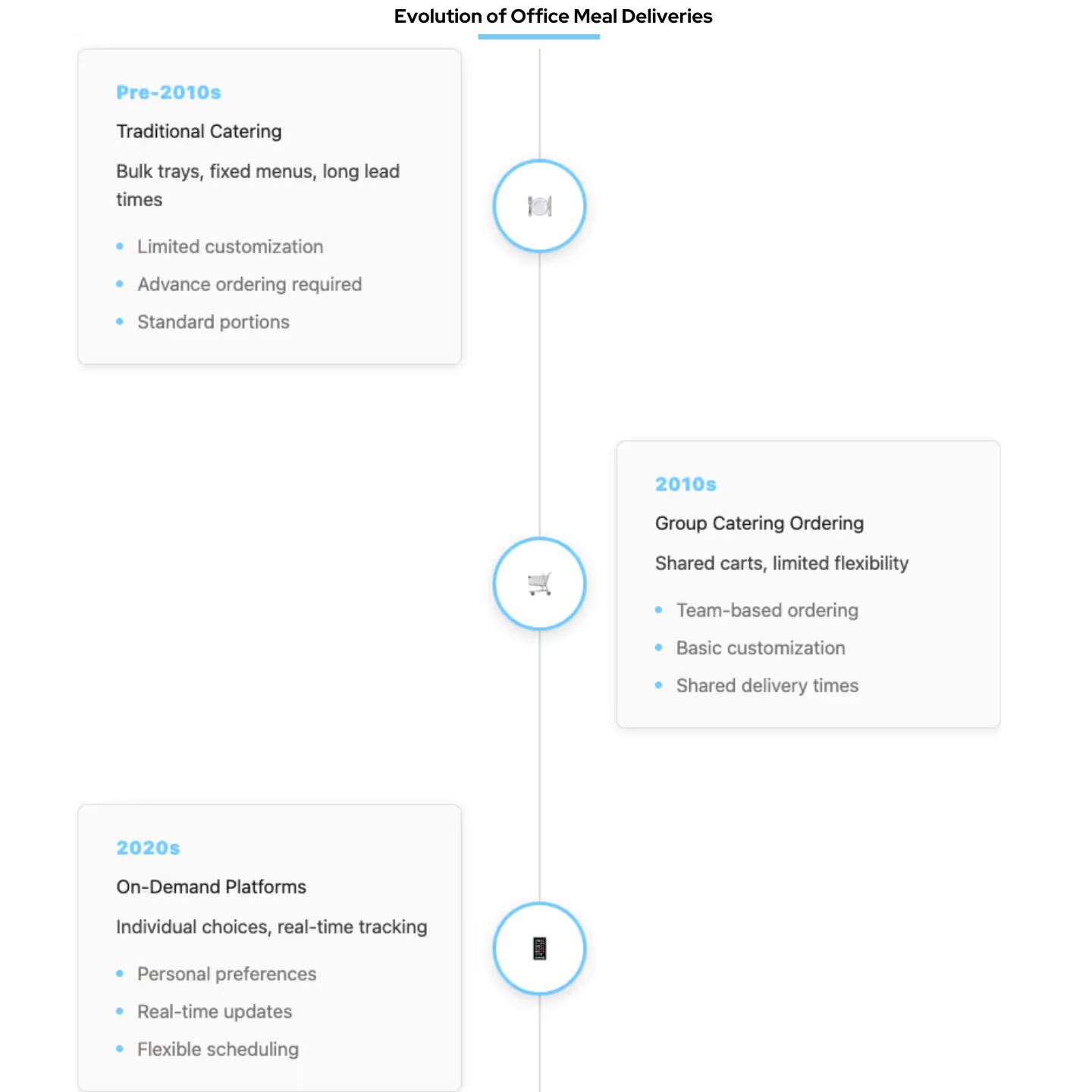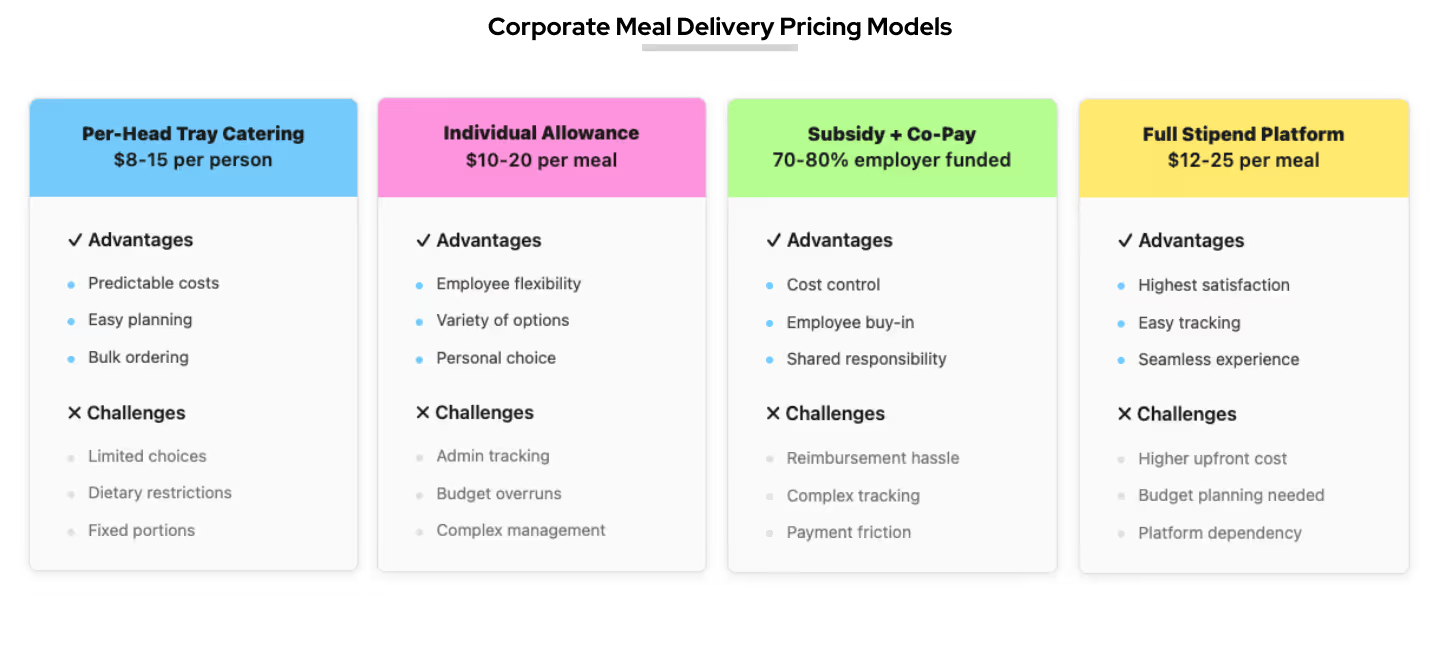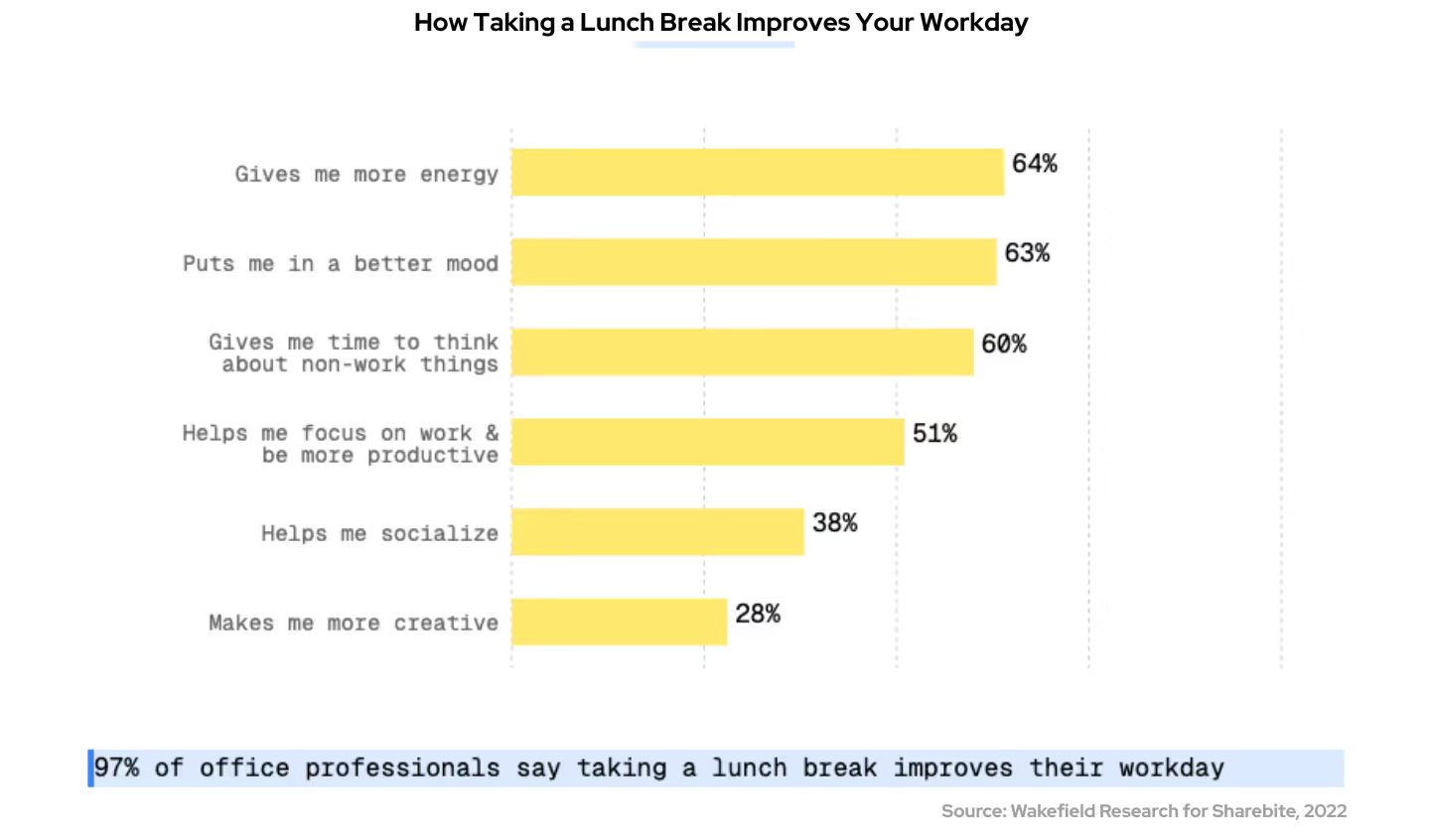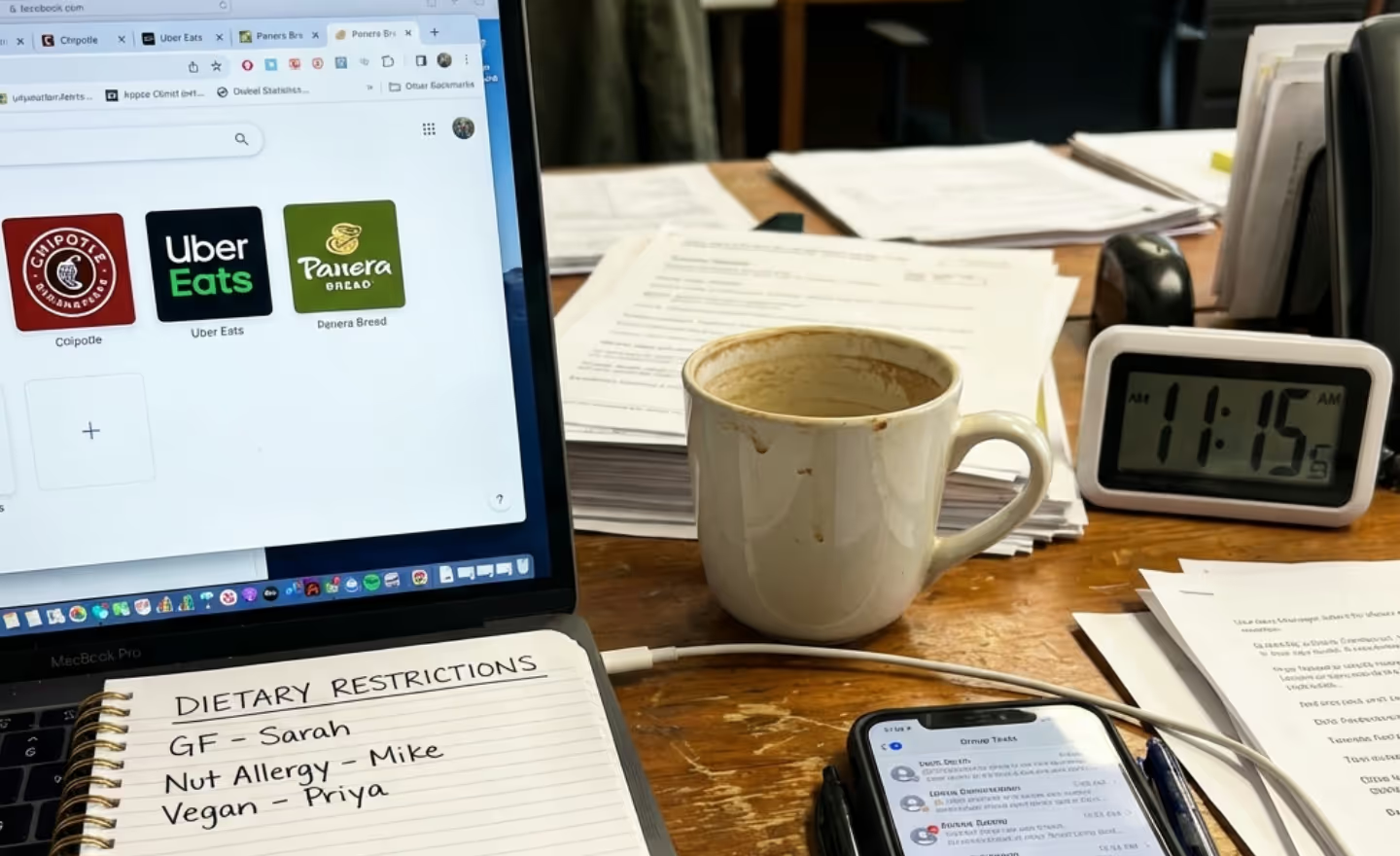Nearly 40% of hybrid workers say free meals would bring them to the office more often, highlighting how essential employee meal benefits are in 2025. Sharebite takes this a step further by turning every corporate meal delivery into an act of community support. For every order placed on our platform, we donate a meal to a person facing food insecurity.
As an HR or People Operations leader, you constantly balance the need to retain top talent with the pressure to control budgets and deliver on social responsibility goals. A well-designed meal program is more than a perk; it is a strategic tool. Sharebite's unique approach proves you can feed your team while supporting your budget, strengthening your culture, and making a tangible impact in your community.
Office Meal Deliveries Explained
Office meal delivery means scheduled or on-demand meals ordered by employers for employees, often with partial or full funding from the company. This post will cover how these programs have changed, how pricing works, and which features matter most for HR and Finance leaders.
From Traditional Catering to On-Demand Platforms
Office meals have changed a lot in the last decade.
Traditional catering focused on bulk trays, fixed menus, and long lead times. Employees with dietary restrictions had few options.
In the 2010s, group ordering portals arrived. Teams could share a cart, but flexibility was limited and the experience could be clunky.
The 2020s introduced on-demand platforms. Food delivery apps, mobile ordering, and individual meal choices became the norm. Employees can now order what they want, track deliveries in real time, and choose meals that fit their diets.
This change is driven by hybrid work, a wider range of dietary needs, and the demand for technology that works with existing workplace tools. Group ordering, meal stipends, and flexible allowances are now standard.

Common Pricing Models and Allowances
Companies use several pricing models for corporate meal delivery:
- Per-Head Tray Catering: Fixed price per person. This brings predictable cost, but limited meal choice.
- Individual Allowance: Each employee gets a daily or weekly meal budget. This offers flexibility, but can require admin tracking without Sharebite.
- Subsidy plus Employee Co-Pay: The employer covers a set percentage, and the employee pays the rest. This helps control budgets but adds steps for reimbursement when not using Sharebite.
- Full Stipend via Platform (like Sharebite): The employer funds all meals through the platform. This brings the highest satisfaction but needs clear budgeting.
Typical per-meal budgets range from $10 to $25. Finance teams value real-time visibility and spend controls, so easy tracking is a must.
An "allowance" is a set budget per employee for meals during work hours.

Key Features to Expect in a Modern Solution
A modern corporate meal delivery platform should include these features:
- Real-time spend dashboards for instant tracking
- Dietary filters, such as vegetarian, vegan, gluten-free, kosher, and halal options
- Access to a local restaurant network, supporting independent businesses
- CSR integration with a built-in meal donation for every order
- Mobile and desktop ordering for a smooth experience
- HRIS and expense tool integration for automatic allowance enforcement and reporting
- Reliable, on-time delivery with more than 96% arriving without delays
Benefits for Employees, Employers, and Communities
A great meal program benefits your team, your company, and your community.
Boosting Engagement and Retention
Taking lunch breaks improves workplace performance, with 97% of office professionals reporting that lunch breaks improve their workday. Specifically, 64% say it gives them more energy, 63% report better mood, and 51% say it helps them focus and be more productive, according to Sharebite's research conducted by Wakefield Research.
This often shows up in a higher Employee Net Promoter Score, a measure of whether your team would recommend your company as a great place to work.

Reducing Administrative Burden and Costs
Automated platforms like Sharebite replace manual reimbursements with several benefits:
- Centralized invoicing with one vendor and one bill
- Automated tax compliance and IRS-ready reporting
- Time savings, as one Benefits Manager shared saving five hours per week
- Companies see an average 15 percent reduction in cost compared to ad-hoc expensing
Fighting Food Insecurity With Every Order
Food insecurity means not having reliable access to affordable, nutritious food. Sharebite addresses this with every order. In 2024, Sharebite clients helped donate ten million meals. In addition, 81 percent of transactions support neighborhood restaurants, keeping funds local.
Companies also improve their brand by aligning meal benefits with social impact goals.
How Sharebite Turns Lunch Into Local Impact
Sharebite’s model supports independent restaurants, donates meals, and integrates easily with HR tools.
Partnering With Independent Restaurants
Sharebite vets local restaurants for quality and safety, then creates a revenue-sharing model that benefits small businesses. In 2024, Sharebite supported 66,924 restaurants with Passport orders. Eighty-one percent of transactions went directly to eateries, helping them avoid third-party delivery fees.
One Order Equals One Meal Donated
Here’s how the donation works:
- Place an order.
- The platform logs the equivalent meal count.
- Meals are donated quarterly in bulk to Feeding America and City Harvest partner food banks.
Donations are verified by independent nonprofit accountants every year.
Seamless Integrations With HRIS and Expense Tools
Sharebite connects with systems like Workday, ADP, and SAP Concur. Benefits include single sign-on for employees, real-time ledger entries, handling of GL expense codes, and API access for custom workflows.
Implementation Roadmap for HR Teams
You can launch in two or three weeks using this roadmap:
- Set budgets and dietary preferences. Define per-employee allowance tiers and upload dietary data from onboarding.
- Launch an employee communication plan. Send a kickoff email, post FAQs, and host a 15-minute live demo or Loom video. Highlight free lunches and community impact.
- Track orders, spend, and donations in real time. Use dashboards to monitor budgets, meal counts, and donations. Schedule monthly auto-reports for Finance and CSR.
Measuring Success and ROI
Data can easily prove the program’s value to your leadership team and your profit. Here are some metrics that can be used to showcase the overall success of a qualiy employee meal allowance program.
Employee Satisfaction and Usage Metrics
Track adoption rate, repeat orders, and eNPS changes. Run a five-question survey after 30 days for quick feedback.
Cost and Time Savings Analysis
Compare admin hours, delivery fees, and expense reimbursements before and after implementation. Calculate ROI with this formula: (Savings minus Program Cost) divided by Program Cost, then multiplied by 100.
CSR Impact Reporting for Stakeholders
Include in your board deck the total meals donated and amounts of reduced food waste due to employees ordering exactly what they want.
CSR stands for Corporate Social Responsibility, which means a company’s commitment to environmental and social well-being.
Ready to feed your teams?
Want to see how Sharebite can help your company feed teams, support local businesses, and make a real social impact with every lunch? Schedule a demo today.
Frequently Asked Questions
How quickly can we roll out Sharebite across multiple offices?
Most companies launch Sharebite within two weeks of signing a contract. The platform can deploy across multiple offices using automated HRIS integrations and onboarding workflows. Larger companies may need two to three weeks for full rollout.
What percentage of our spend supports local restaurants?
Sharebite charges restaurants only a 15 percent commission, compared to the 25 to 35 percent common on other platforms. This means local restaurant partners keep 85 percent of food revenue from Sharebite orders.
How does Sharebite verify each meal donation?
For every meal ordered through Sharebite, a corresponding donation is made to leading food bank partners such as Feeding America and City Harvest, following their standards for what constitutes a meal. Sharebite tracks each meal purchased on its platform and makes quarterly donations based on the total number of meals ordered, ensuring that every order placed translates into real, nourishing support for someone facing food insecurity. Clients can view real-time donation tracking and verification through their Sharebite dashboard, providing full transparency into the impact their team is making.
Can we customize daily allowances for hybrid employees?
Yes. You can set different allowances by group or location using the self-service admin dashboard.
What integrations are available with accounting software?
Sharebite offers robust expense tracking, GL coding, and can sync with accounting systems. Custom API integrations are available for various needs.






